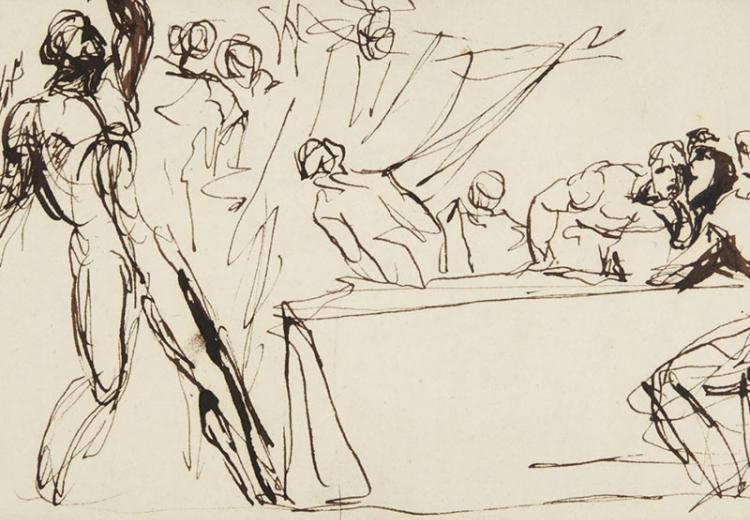Shakespeare's "Macbeth": Fear and the "Dagger of the Mind"

Macbeth encountering Banquo's ghost. A study by 18th century artist George Romney for his depiction of the "banquet scene."
Art thou not, fatal vision, sensible
To feeling as to sight? or art thou but
A dagger of the mind, a false creation,
Proceeding from the heat-oppressed brain
In his novel, Voyage of the Dawn Treader, C.S. Lewis chronicles an island where all dreams come true. Sounds wonderful, right? But think about it a moment. All dreams. Our fondest wishes, but also our most terrifying fears. On this island, we would meet every shadowy thing we ever imagined to be lurking in the darkness, every terrifying image we ever tried to thrust from our mind.
This is Macbeth's situation. Just as the three Weird Sisters predicted, or perhaps precipitated, his fondest wishes, his secret dreams of power, have all come true. But so too have his darkest fears. In the course of the play, we see Macbeth struggling against those phantoms, struggling to master or eradicate his own fears. "I am cabin'd, cribb'd, confined, bound in / To saucy doubts and fears" (3.4.24-25), he laments to the men he has hired to murder Banquo. He has won the crown, but his mind is poisoned, his tranquillity lost. He cannot enjoy his triumph, cannot rest, cannot sleep.
Shakespeare's preeminence as a dramatist rests in part on his capacity to create vivid metaphors and images that embody simple and powerful human emotions. This lesson is designed to help students understand how Shakespeare's language dramatizes one such emotion: fear. Students will work in small groups to perform the so-called "banquet scene," in which the newly-crowned Macbeth, while entertaining the lords of Scotland, encounters a ghost only he can see. The twist here is that while there will be opportunities for students to analyze Shakespeare's language, the performance itself will be done without words. The wordless performance means that students will need to develop physical equivalents for the clues to Macbeth's state of mind that are embedded in Shakespeare's poetry.
Note: This lesson may be taught either as a stand-alone lesson or as a prequel to the complementary EDSITEment lesson, "Shakespeare's Macbeth: Fear and the Motives of Evil." The second lesson takes a broader look at fear in the play, exploring how fear becomes not just merely the result of Macbeth's actions, but a cause of his increasingly desperate and evil actions. While the activities in the present lesson center around students' performance of one scene, in "Shakespeare's Macbeth: Fear and the Motives of Evil" students use a search engine to locate and analyze key passages throughout the play that suggest the motives of Macbeth's precipitous descent into evil.
Guiding Questions
Why is Macbeth, whom we know to be brave and ruthless in battle, so afraid?
How does Shakespeare dramatize Macbeth's fear?
Learning Objectives
Analyze how Shakespearean metaphors, imagery, and another dramatic cues reveal Macbeth's response to fear
Perform without words a scene dramatizing Macbeth's response to fear
